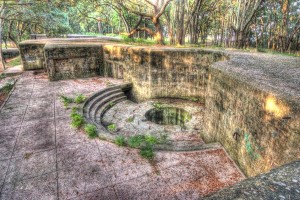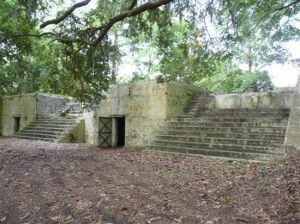Fort Freemont, an abandoned US Military installation in Beaufort County, is perhaps my favorite 20th century ruin in the SC Lowcountry. Now a part of Fort Fremont Preserve owned by the Beaufort County Rural and Critical Lands Program, no period guns or carriages in place but some of the battery structures and massive turret mounts remain.
Fremont was constructed after 1875 to defend Port Royal Sound and the Naval Station on Parris Island (that’s where we send our Marines for training, if the name rings a bell). The Fort was named after General Charles C. Freemont of Savannah, Georgia who was one of four major generals appointed by Lincoln. He became wealthy during the California Gold Rush, later becoming a Senator from that State. In 1856, the Georgian was the first Republican presidential nominee (losing to James Buchanan) and his abolitionist views first raised the specter of Southern secession from the Union if elected. He died in New York City on July 13, 1890, nine years before the fort that bears his name was completed.
In 1875 the site was merely a wharf into the Port Royal Sound and a wooden hospital. When the Spanish-American war began, they replaced the wooden structure with a concrete one. The first battery appeared in 1898, followed by Battery Jessup and Battery Fornance in 1899.
The first commander of Fort Fremont was Lt. Johnson Hagood, First Artillery, of Citadel fame. After Hagood married in December of 1899, a Capt. Knowlton and Lt. Stanley D. Embrick succeeded him for the following two years.
According to the November 7, 1901 Palmetto Post, Capt. Knowlton recommended that the War Department buy adjoining land from African-American owners, in order to drain ponds and improve sanitary conditions for soldiers and civilians alike. Lt. Embrick had earlier made similar improvements on the premises.
The full company of personnel at Fort Fremont was set at 108 men in July of 1908, when 40 newcomers arrived from Columbus, Ohio. The 1907 payroll for the fort was $2,000 a month and $22,000 were spent on improvements to the facility in that year. Fort Fremont had the second-lowest number of desertions in the United States in the year 1910.
In June1910, violence erupted between artillerymen at the fort and African-American civilians, involving the sale of illegal “blind tiger liquor” by the locals. Following several fights and gun fights, six soldiers were wounded and one killed. Isaiah Potter, arrested for the fatal shooting, claimed that the trouble began with what the Beaufort Gazette called “intimacy between (Potter’s) wife and a private soldier.”
The same Beaufort Gazette article indicated that Fort Fremont’s soldiers were in frequent social contact with the townspeople of Beaufort: Pvt. Frank J. Quigley, the slain soldier, had been “well known and liked in Beaufort and in many of the towns in which the Beaufort baseball team played last season, having played behind the bat for the Fort Fremont team and the Beaufort team.”
Quigley is rumored to be the source of the as-yet unexplained “Lands End Light,” occasionally seen drifting down the deserted road leading to Fort Fremont. At its peak, the Fort was in use by over 100 men of the 116th Coast Artillery and included a hospital, barracks, stables, guardhouses, and commissary.
A December 7, 1921 Charleston News and Courier article reported that the U.S. Treasury Department requested Fort Fremont from the U.S. War Department for use as a quarantine station. The property had by then been placed on the Secretary of War’s list of properties no longer needed for military purposes and available for sale. Fort Fremont was subsequently deactivated as a military installation in 1921 and was sold at public auction in 1930.
As of December 2012, Battery Fornance has been overbuilt and is no longer extant. Battery Jesup is structurally intact. The 1904 brick hospital building is the only remaining original building on the fort site, it is in use as a private residence
Visit Friends of Fremont here: http://www.fortfremont.org and stay tuned for a full blog post on Fort Fremont and many more photos of the ruins.

















